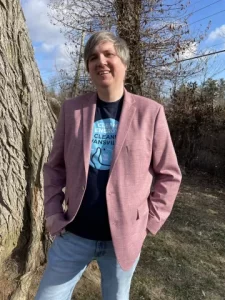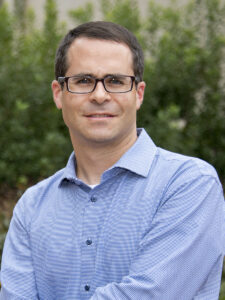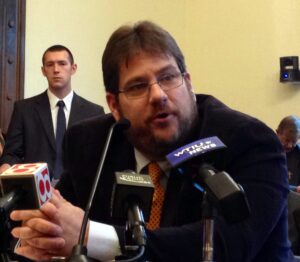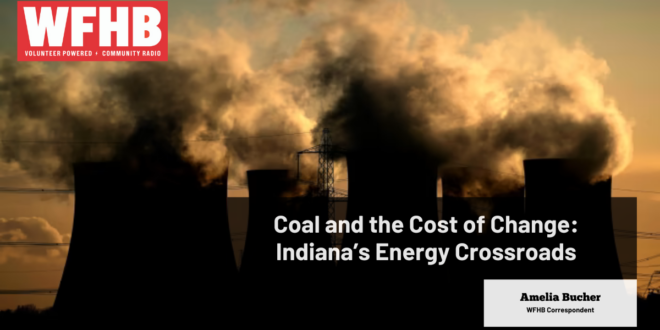Podcast: Play in new window | Download (Duration: 12:18 — 17.0MB)
Subscribe: RSS
While it may seem a little outdated, the primary source of energy in Indiana is coal. As the state faces pressure to reduce emissions and transition to renewable energy, it is important to consider the economic and social impact the transition will cause. What exactly will it take? And why has this transition taken so long?
“We are at a pivotal moment in time, if you will, with energy, and we are at, even though we’ve been at this fork in the road, we are really at the fork in the road right now, because we are at the point in time where we are deciding which path we are going to take. Are we going to embrace the clean energy revolution? Are we going to embrace lower cost, affordable energy and sustainable local jobs that can’t be outsourced by increasing investments in distributed generation, energy efficiency, those sorts of things, and renewable energy? Or are we going to continue down the same old, same old business path as usual, of investing in highly capital intensive thermoelectric plants that create wealth at the expense of the working class,” said Olson.
That was Kerwin Olson, the Executive Director of the Citizens Action Coalition, Indiana’s oldest and largest consumer and environmental advocacy organization.
When you think of coal, many images may come to mind, including power plants and plumes of thick, black smoke. Some think of greedy corporations or even corrupt politicians. You may even envision images of a Christmas with coal stuffed stockings. Regardless of what you think, coal is the main source of electrical energy in Indiana, and it is having detrimental consequences on our environment.
Coal power plants generate electricity by burning coal to create steam, which spins a turbine that creates electricity. In 2023, coal’s share of Indiana’s net generation ranked the 7th highest out of all US states. By capacity, 8 of Indiana’s 10 largest power plants are majority coal powered. By annual generation, 7 of its 10 are majority coal powered. In 2013, 84% of all power generation in the state was coal. By 2023, this number had reduced down to 45%.
Bituminous coal was first discovered in Indiana along the Wabash River in 1736. Coal mining began in Indiana in the middle 1800s using underground mining, a method of extracting minerals from beneath the Earth’s surface by creating tunnels or shafts. Steam-powered equipment began being used in the early 1900s to remove coal. Today, surface mining is the primary method of coal removal in Indiana which removes soil and rock to expose and extract minerals from the Earth’s surface.
Coal is used in a series of ways including manufacturing such as the creation of cement, carbon fibers, medicines, and tars, while also serving as a huge contributor to the state’s steel industry. All are valuable materials that account for peoples’ jobs, local economies, and most prominently energy production.
Coal power plants are considered baseload generation, meaning that they operate all day and all night, constantly supplying power to run Indiana’s homes and businesses. Coal is abundant, reliable, and affordable, which makes it a great energy for Hoosiers. So why is it such a huge problem? WFHB News spoke with Robyn Skuya-Boss, a Chapter Director in Indiana for the Sierra Club, to discuss some of coal’s impacts.

“And what we discovered when we were looking at how do we really take on climate change and the urgency of our climate crisis in order to really identify where we could best focusing our efforts and really making an impact in our overall greenhouse gas emissions. What we found is that our energy sector, when you really break it down, coal fired power plants, are one of the leading contributors to greenhouse gas emissions. And of course, that corresponds with a lot of pollution that impacts public health, whether you’re looking at sulfur dioxide, nitrous oxide, things that contribute to smog and soot,” said Skuya-Boss.
The Sierra Club is an environmental organization that advocates for the protection of the planet, people, and places. They are one of the oldest and largest environmental organizations in the United States. As for the urgency of these environment issues, Professor David Konisky, a professor at the O’Neill School of Public and Environmental Affairs and Co-Direct of the Energy Justice Lab, discusses some concerns surrounding carbon emissions,
“Emissions are well documented that the emissions coming from the combustion of those sources produces greenhouse gases, the gases that are contributing to climate change. So to the degree that we are not moving quicker, more quickly away from these sources, we are just exacerbating the climate problem. And that not only has long-term implications, but we’ve begun to see that climate change is no longer just a future issue. It’s here with us and we’re seeing everything from extreme weather events to more severe storms, and that affects all of us.”
There are many misconceptions surrounding renewable energy, including it being too expensive, not able to meet energy demands, and that it is impractical on a large scale. So how can we answer some of the claims?
“I think maybe there’s a conventional wisdom that renewable sources of energy cannot supply a good amount of the electricity that we need, particularly as we try to electrify our economy to reduce our use of fossil fuels. But the reality is that in most parts of the United States, renewable energies are just as cost effective, if not less expensive than more traditional fossil fuels. And there are ways to solve the intermittency problem that people often will point to, that the sun isn’t always shining and the wind isn’t always blowing. Those technologies now are really efficient. They work well with batteries and other types of technologies that make them potentially a really big part of the solution. And it’s really more a matter of political will, and it is technological complications,” said Konisky.

So if it is a matter of political will, what is currently being done? Skuya-Boss, talks about some current legislation attempting to be passed in Indiana.
“In Indiana, since 2005 we’ve reduced greenhouse gas emissions by 25% and that is progress that’s worth protecting. And right now what we are faced with particularly in House Bill 1007, which is a bill that puts in place some barriers to retiring coal plants, particularly by adding additional layers of regulatory steps that utility companies will have to jump through in order to follow through on their commitments to retire coal plants by 2030, and that is a bill that could potentially roll back some of that progress.”
Indiana House Bill 1007 deals with energy generation resources, something that has direct ties within the fight to stop the use of coal power. The bill proposes a 20% tax credit for any expenses created in the building of a small modular nuclear reactor or SMR in Indiana.
From the Citizens’ Action Coalition “House Bill 1007 provides the monopoly utilities with a massive tracker that forces customers to assume the financial risk and foot the bill for the SMR development costs before the utility has even sought approval from the IURC to construct an SMR, and even if the utility never seeks approval to construct an SMR and cancels the project.”
The bill, if passed, will reduce the regulatory oversight of utility companies when they file for approval of new generation resources – resources that support Big Tech companies and their initiatives. More specifically, the bill will make it more difficult for the utilities to retire coal power plants, which would significantly slow the clean energy transition in Indiana. Skuya-Boss discusses some of the motivation behind the bill.
“In part, the motivation for House Bill 1007 does appear to be really making Indiana an attractive state for new data centers, which are very, very energy intensive, and there is just a large amount of energy that is needed to meet the demand of these new this potential new economic development and ultimately what we don’t want to see is that progress we’ve made rolled back because we end up having to build out a lot more fossil fuel infrastructure in order to meet that demand. And so we do need a more measured approach and not sort of effort by state leaders and lawmakers to put the costs and the risks of building out things like small modular nuclear reactors, which have a huge price tag, and also potentially fast tracking things like developing new gas plants or rolling back coal plants that have already been committed to retire.”
It is also important to note that while the fight for SMRs is strong and they are being proposed as a solution to the energy crisis, zero are operating in the US. Olson comments,
“And they do that in Indiana by spending money. The more money they spend, the more money they make. And so they will always choose the most expensive option, because that delivers the highest returns to the company. And you don’t have to think too hard about it. The reason utility companies do not invest in renewable energy is because it delivers far less earnings, far less profit, far less capital. And so to make money, you gotta spend the money, and so they want to feed the coffers of Wall Street and choose capital intensive projects that, you know, the old, you know, Reagan line of trickle down. It’s all about wealth creation, period. Hard stop.”
The 2025 Indiana General Assembly is considered a “long” session due the creation of the biennial budget. While many different types of bills are being heard, this session is especially important for the environment. Olson talks about this importance and how it will affect consumers:
“This is a fairly brutal session if you’re a consumer and environmental advocate, but that’s largely been the case since super majority took over in 2012 and that’s largely been at the case at the Indiana State House, irrespective of which party is in charge, our environment, our natural resources, our democracy and our utility bills have always been under attack and under assault,” summarizes Olson.
Wealth and the environment have been intertwined from the very beginning. Olson said the people currently in-charge of our energy supply want to make money for the amount of work they are providing and power they are generating. It gets even messier when you involve the amount of political investors that enter the picture and begin to affect legislation. Olson remarks,
“It is about wealth creation and creating wealth in the marketplace. And you do that through building really expensive stuff, which is coal plants, gas plants, pipelines and nuclear reactors, those windmills, those solars, those new light bulbs, insulating homes, heat pumps, that stuff doesn’t deliver earnings to their shareholders, but boy, gas plants, new plants, coal plants, pipelines, sure do so.”
Olson puts it more simply,
“The more they spend, the more they make.”

So if this is the case, what can change? One way that is being proposed is to transition to a cleaner industrial process and transportation. Olson speaks more on this transition process:
“And the need to transition to clean energy for heating and cooling our homes and for our industrial processes is is critical, but as well as for transportation, as well. We certainly, we sometimes pigeon hole the climate conversation into only electricity and our light switch, but the impact climate because of transportation policies and other things is extraordinary, as well as industrial processes as well. So we have to not only decarbonize the grid, we have to do everything in our power to decarbonize industrial processes, heavy manufacturing, aviation, heavy transportation and everything else. It’s a heavy lift. But, you know, we can get it done,” added Olson.
The biggest roadblock we face today is not technology or resources—it’s political will. We have the science, the technology, and the economic data to prove that cleaner energy and greater efficiency save us all money, but politicians are still saying ‘no.’ And this problem isn’t just limited to energy—it stretches into healthcare, education, and every corner of our lives.
While it is easy to get discouraged in the face of the environmental crisis, it is important to
remember that there are people fighting on behalf of our environment.
For the Sierra Club, Skuya-Boss comments,
“The easiest thing folks can do is just go to sierraclub.org/indiana. We have an upcoming events web page, so if you want to get outdoors with us, we have our upcoming outings on there. We also have our seeds of Democracy Program, which is really focusing on engaging around the state legislative session. And yeah, that’s going to be a really excellent way for people to kind of get involved with Sierra Club is just come, come hang out in the woods with us.”
More information on the Citizens Action Coalition can be found on their website, www.citact.org.
 WFHB Bloomington Community Radio
WFHB Bloomington Community Radio


